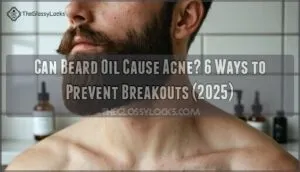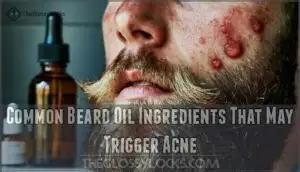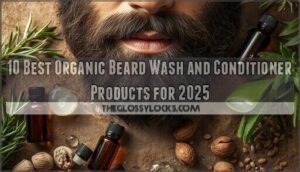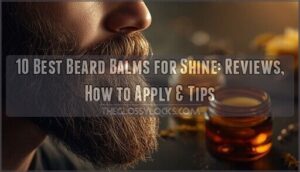This site is supported by our readers. We may earn a commission, at no cost to you, if you purchase through links.

However, you can prevent breakouts by choosing non-comedogenic oils such as jojoba or argan oil, which won’t block your pores.
Your skin type plays a vital role – if you’re acne-prone, you’ll need to be more selective about ingredients and application methods.
The trick isn’t avoiding beard oil entirely, but understanding which formulations work with your skin rather than against it, using smart ingredient choices and proper application techniques can keep both your beard and skin looking their best.
Table Of Contents
- Key Takeaways
- The Relationship Between Beard Oil and Acne
- Common Beard Oil Ingredients That May Trigger Acne
- Non-Comedogenic Beard Oil Ingredients for Clear Skin
- Balancing Natural Oils and Sebum Production
- Proper Application Techniques to Prevent Breakouts
- Signs Beard Oil May Be Causing Acne
- Alternatives for Acne-Prone Beard Care
- Treating Existing Acne While Using Beard Oil
- Long-Term Effects of Beard Oil on Skin Health
- Choosing The Right Beard Oil for Your Skin Type
- Frequently Asked Questions (FAQs)
- Why is my beard acne so bad?
- Should you use beard oil if you have acne?
- Does Beard oil itch a lot?
- Does removing a beard cause acne?
- Can oily skin cause acne?
- Can hair care products cause acne?
- What beard oils don t clog pores?
- Does a beard worsen acne?
- What beard oil doesn’t cause acne?
- What are the negatives of beard oil?
- Conclusion
Key Takeaways
- You’ll avoid breakouts by choosing non-comedogenic oils like jojoba or argan instead of pore-clogging ingredients such as coconut oil, which has a comedogenic rating of 4
- You can prevent beard oil acne by applying only 2-3 drops for shorter beards, cleansing your face before application, and distributing the oil evenly to avoid concentrated spots that clog pores
- You’ll know beard oil is causing problems when you notice new breakouts specifically in your beard area, increased skin oiliness, or blackheads forming around hair follicles
- You should patch test new products behind your ear first and consider lightweight alternatives like water-based moisturizers or serums if traditional oils consistently trigger breakouts
The Relationship Between Beard Oil and Acne
You might wonder if that beard oil you’re using could be causing those pesky breakouts around your jawline.
The truth is, beard oil doesn’t directly cause acne, but certain ingredients and application habits can definitely contribute to clogged pores and breakouts.
Comedogenic Vs Non-Comedogenic Ingredients
Not all comedogenic ingredients play nice with your skin.
Comedogenic beard oil contains components that block pores, while noncomedogenic options won’t interfere with oil absorption.
Check ingredient labeling carefully—your skin barrier depends on it.
Think of noncomedogenic beard oil as your skin’s best friend, letting it breathe while keeping whiskers conditioned without poreclogging drama.
Pore-Clogging Potential of Beard Oils
When choosing comedogenic beard oil, you’re risking clogged pores beard issues.
Oil buildup creates a perfect storm for breakouts by trapping dirt and bacteria. Heavy formulations can cause skin suffocation, especially if your pore size allows easy blockage.
Poreclogging happens when oils don’t absorb properly. Choose noncomedogenic beard oil instead, and remember cleansing importance—it prevents beard oil acne from ruining your grooming routine.
Consistent use can provide hydrating and nourishing properties.
Skin Type Considerations
Your skin type determines how well you’ll handle beard oil. Oily Skin tends to produce excess sebum, making lightweight formulas essential. Sensitive Skin reacts poorly to harsh ingredients, requiring gentle options. Dry Skin craves richer oils for proper hydration.
Here’s your Product Selection roadmap:
- Oily/Acne-Prone Skin: Choose non-comedogenic oils like jojoba or argan
- Sensitive Skin: Opt for fragrance-free, hypoallergenic formulations
- Dry Skin: Select nourishing oils like sweet almond or grapeseed
Understanding your skin sensitivity and oil production patterns helps prevent breakouts while keeping your beard healthy.
Acne-Prone Skin and Beard Oil Use
If you have acne-prone skin, beard oil isn’t automatically off-limits, but you’ll need smart choices.
Patch testing prevents nasty surprises, while non-comedogenic ingredients like jojoba oil won’t trigger beard oil breakouts.
Skip pore-clogging culprits like coconut oil.
Apply sparingly—application frequency matters more than amount.
Cleansing importance can’t be overstated; clean skin absorbs oil better, reducing beard acne causes.
Common Beard Oil Ingredients That May Trigger Acne
Not all beard oils are created equal, and some ingredients can actually make acne worse if you’re prone to breakouts.
Coconut oil, soybean oil, and other heavy ingredients have high comedogenic ratings, which means they’re more likely to clog your pores.
And trigger those unwanted pimples.
Coconut Oil and Its Comedogenic Rating
Why does coconut oil wreak havoc on your skin?
With a comedogenic rating of 4, coconut oil’s fatty acid profile creates a perfect storm for pore clogging.
This popular beard oil ingredient blocks follicles, trapping bacteria and triggering acne breakouts.
Despite its moisturizing benefits, usage amount matters—even small quantities can cause problems for acne-prone skin.
Avocado Oil’s Impact on Acne-Prone Skin
While coconut oil sits at a high comedogenic rating, avocado oil presents a different challenge for your beard care routine.
Avocado oil’s moderate comedogenic rating of 2-3 means it can trigger breakouts, especially if you’re dealing with oily or acne-prone skin.
Its fatty acid profile, rich in oleic acid, may disrupt your skin barrier repair process.
Here’s what you need to know:
- Comedogenicity concerns: Higher oleic acid content can worsen oil-induced acne
- Anti-inflammatory effects: May reduce redness but risk clogged pores
- Usage best practices: Patch test before applying to acne-prone skin
- Skin compatibility: Works better for dry skin than oily types
Monitor your skin closely when using avocado oil-based beard products.
Soybean Oil and Pore Clogging
Soybean oil ranks as a comedogenic ingredient with a rating of 3, meaning it’s likely to clog pores and trigger acne breakouts.
This beard oil component’s oil extraction methods and processing can increase its allergenicity concerns.
If you’re prone to breakouts, consider alternative oils like jojoba or argan instead.
Flaxseed Oil’s Effects on Facial Skin
Beyond soybean oil’s pore-clogging reputation, flaxseed oil presents its own challenges for facial hair acne and acne-prone skin.
This omega-3 rich ingredient offers impressive flaxseed benefits through topical application, including enhanced skin hydration and inflammation reduction. However, its comedogenic rating of 4 means significant risk for beard oil acne.
- Flaxseed Benefits: Contains 50-60% alpha-linolenic acid for moisture retention
- Omega-3 Absorption: Reduces inflammatory cytokines when applied topically
- Skin Hydration: Improves barrier function and decreases water loss
- Inflammation Reduction: Soothes redness and irritation in sensitive areas
- Skin Care: Requires patch testing due to pore-clogging potential and skin irritation beard risks
Marula Oil and Acne Concerns
Marula oil often appears in premium beard products, but it’s not always skin-friendly.
With a comedogenic rating of 3-4, this oil can clog pores and trigger breakouts, especially for acne-prone skin. The extraction methods and oil purity affect marula comedogenicity.
Those with sensitive skin may experience allergic reactions. Consider switching to noncomedogenic oils like jojoba for safer beard care.
Non-Comedogenic Beard Oil Ingredients for Clear Skin
When you’re dealing with acne-prone skin, choosing the right beard oil ingredients can make the difference between clear skin and frustrating breakouts.
Non-comedogenic oils won’t clog your pores, letting you maintain a healthy beard without sacrificing your complexion.
Argan Oil Benefits for Beards and Skin
Argan oil stands out as the gold standard for acne-prone skin seeking beard oil benefits.
This Moroccan treasure delivers skin hydration without clogging pores, thanks to its zero comedogenic rating.
Its anti-inflammatory effects calm irritated skin while promoting hair strengthening.
You’ll notice softer whiskers and scar reduction over time.
Many users find argan oil products beneficial for beard care.
Unlike problematic beard oil ingredients, argan oil works with your skin care products rather than against them.
Jojoba Oil as a Sebum Mimic
Jojoba oil’s sebum similarity makes it perfect for acne-prone skin.
Your oil glands can’t tell the difference between jojoba and natural sebum, so they’ll produce less oil naturally. This lightweight champion absorbs quickly without leaving greasy residue.
Many users find jojoba oil beneficial for beard care.
- Regulates sebum production naturally
- Provides skin compatibility for sensitive areas
- Offers superior absorption rate compared to heavier oils
Sweet Almond Oil for Beard Conditioning
Sweet almond oil delivers exceptional hair conditioning without triggering breakouts on acne-prone skin. This lightweight champion boasts a comedogenic rating of 2, making it suitable for most skin types. Rich in vitamin E and fatty acids, it softens coarse beard hair while nourishing underlying skin.
| Almond Oil Benefits | Details |
|---|---|
| Skin Type Suitability | Safe for normal to slightly oily skin |
| Application Frequency | 2-3 times weekly for sensitive skin |
| Potential Allergies | Tree nut allergies may cause reactions |
However, those with tree nut sensitivities should patch test first to avoid beard oil side effects. You can find various options online. Unlike heavier comedogenic ingredients, sweet almond oil absorbs quickly without leaving greasy residue that could worsen beard care acne concerns.
Tea Tree Oil’s Antibacterial Properties
Tea tree benefits shine when battling acne-causing bacteria. This potent oil delivers antibacterial power directly to problem areas, reducing breakouts by 44% in clinical studies.
Its anti-inflammatory properties calm irritated skin without clogging pores. Perfect for acne treatment, tea tree oil penetrates deep into follicles where bacteria hide, making it ideal for beard care routines.
Grapeseed Oil for Lightweight Moisturizing
Most guys think heavier equals better moisturizing, but grapeseed oil proves them wrong. This lightweight champion delivers serious Lightweight Hydration without triggering breakouts on acne-prone skin.
Here’s why grapeseed oil rocks for natural beard oil formulations:
- Absorption Rate beats heavy oils—no greasy residue lingering around
- Regulates Oil Production instead of overwhelming your skin’s natural balance
- Grapeseed Benefits include vitamin E and antioxidants for healthier follicles
- Zero comedogenic rating means serious Acne Prevention power
- Perfect skin moisturization without suffocating pores underneath your beard
It can even offer protection against UV damage.
Balancing Natural Oils and Sebum Production
Your skin naturally produces sebum, an oily substance that keeps your face moisturized and protected.
Sebum is your skin’s built-in moisturizer, working around the clock to keep your face soft and protected.
When you add beard oil to the mix, you’re basically layering additional oils on top of your skin’s natural production, which can either help balance things out or create a greasy mess that clogs pores.
Understanding Skin’s Natural Oil Production
Your sebaceous glands work like tiny oil pumps, producing sebum to keep skin healthy and protected.
This natural oil production varies by skin type – some people have naturally oily skin, while others produce less sebum.
Acne-prone skin often overproduces oil, making pore function and oil balance critical for clear skin.
| Skin Type | Sebum Production Level | Acne Risk |
|---|---|---|
| Dry | Low sebum output | Minimal risk |
| Normal | Balanced oil production | Low to moderate |
| Combination | Variable by face zone | Moderate risk |
| Oily | High sebum production | High risk |
| Sensitive | Irregular oil patterns | Variable risk |
Understanding your skin’s natural lipids helps you choose products that support skin regulation rather than disrupting it.
How Beard Oil Affects Sebum Balance
Beard oil disrupts your skin’s natural sebum production, creating a complex balancing act.
When you apply oils, your sebaceous glands may reduce their output, thinking there’s enough moisture. However, heavy formulas can overwhelm acne-prone skin, causing oil-induced acne through pore blockage.
Key effects on sebum balance:
- Natural oil mimicry – Jojoba closely matches your skin’s sebum, promoting healthy regulation
- Oil absorption rates vary – Lightweight oils penetrate better, reducing surface buildup
- Over-application effects confuse skin signals, potentially triggering breakouts in sensitive areas
- Lightweight oil benefits include better skin regulation without disrupting natural processes
Optimal Oil Ratios for Acne-Prone Skin
Optimal Blend Ratios matter more than you think. For acne-prone skin, stick to lightweight oils like jojoba and grapeseed with high linoleic acid content.
Carrier Oil Synergy works best at 60% linoleic to 40% oleic acid ratios. Essential Oil Concentrations shouldn’t exceed 2-3% of your blend.
Skin Barrier Support approach reduces Inflammation Reduction while maintaining effective skintype formulation. Some users find that tea tree oil kills acne-causing bacteria effectively.
Regulating Excess Oil With Proper Products
Managing excess oil requires strategic product selection for acne-prone skin using beard oil acne prevention methods.
Smart product layering creates a protective barrier while maintaining balance:
- Gentle cleansers wash away dirt without stripping natural oils completely
- Oil-control ingredients like niacinamide regulate sebum production effectively
- Skin-friendly oils such as jojoba mimic natural sebum patterns
- Targeted treatments address specific problem areas with precision
- Skin barrier support products strengthen your skin’s natural defenses
Choose the right beard oil with non-comedogenic formulas for ideal acne prevention beard care results.
Proper Application Techniques to Prevent Breakouts
You don’t need to guess about the best way to apply beard oil – the technique makes all the difference between clear skin and breakouts.
Following proper application steps helps your skin absorb the oil without clogging pores, keeping both your beard and face healthy, which is crucial for maintaining clear skin.
Cleansing Before Beard Oil Application
Proper cleansing sets the foundation for effective beard oil application. Think of washing your face like clearing a path—you’re removing barriers that could trap dirt and oil.
Start with lukewarm water to soften your skin and open pores. Choose a gentle cleanser designed for acne-prone skin, avoiding harsh soaps that strip natural oils. This pre-cleanse benefits your beard hygiene and prevents acne by eliminating bacteria before oil application.
Here’s your cleansing routine visualized:
- Steam rising from warm water as you splash your face
- Gentle circular motions working cleanser into your beard area
- Suds lifting away dirt and oil from deep within pores
- Clear water washing away all traces of soap and debris
- A clean, soft towel patting your skin completely dry
Water temperature matters—too hot strips protective oils, while cold water won’t effectively remove buildup. Gentle exfoliation during cleansing helps prevent clogged pores without irritating sensitive skin.
Correct Amount of Oil to Use
How much is too much when applying beard oil?
Start with just 2-3 drops for shorter beards, increasing to 4-6 drops for longer, thicker growth.
Using excessive amounts won’t improve skin hydration—it’ll create a greasy mess that clogs pores.
For acneprone skin, less is always more.
Product concentration matters too; high-quality oils require smaller amounts for effective beard oil application without skin greasing.
Even Distribution Throughout The Beard
The key to avoiding beard oil acne lies in thorough distribution.
Work oil from roots to tips using downward strokes, ensuring every hair gets coverage without creating puddles on your skin.
Use a quality beard comb or boar bristle brush after application—these tools help spread the small amount evenly while preventing concentrated spots that clog pores and trigger breakouts, which is crucial for maintaining healthy skin and avoiding beard oil acne.
Frequency of Application for Acne-Prone Skin
Finding the right application frequency for acne-prone skin requires patience and observation.
Start applying beard oil every other day, then monitor your skin’s response closely. If breakouts occur, switch to a post-wash routine twice weekly.
Seasonal adjustments may be needed – your acneprone beardsman status might require less frequent night application during humid months.
A small amount of oil goes further when beard oil frequency matches your skin type formulation needs.
Avoiding Over-Application and Residue Build-up
Too much beard oil creates greasy buildup that suffocates your skin and clogs pores.
Use a small amount of oil – just 2-3 drops for most beards. Less is more when preventing beard oil acne.
Apply sparingly, massage thoroughly for product absorption, and wash your beard regularly for residue removal to avoid skin suffocation.
Signs Beard Oil May Be Causing Acne
If your beard oil contains the wrong ingredients or you’re using too much, your skin will send clear warning signals.
Watch for new breakouts appearing specifically where your beard grows, increased shine and greasiness on your face, or small bumps and blackheads forming around hair follicles, which can be a sign of using too much beard oil.
New Breakouts in Beard Area
Your skin’s sending a clear message: something’s not working. New breakouts under your facial hair signal beard oil acne triggers at play. Initial Breakout patterns help identify pore-clogging culprits before Breakout Severity escalates.
Identifying Culprits starts with recognizing these warning signs:
- Small whiteheads clustering near your jawline
- Red bumps appearing where oil sits longest
- Delayed Acne showing up 24-48 hours after application
- Pustules forming along your beard’s edges
- Blackheads multiplying in previously clear areas
Managing Breakouts means catching these early signals before your beard grooming acne spirals out of control.
Increased Oiliness of Skin
Notice shiny, greasy skin after applying beard oil? That’s sebum overproduction at work.
Your skin may be drowning in extra oil, creating that slick feeling. This oil buildup leads to skin suffocation, triggering acne triggers and pore congestion.
If your face looks like a mirror, you’re dealing with oil-induced acne from pore-clogging culprits in your beard oil acne.
Clogged Pores and Blackheads
Blackheads form when tiny pores and hair follicles trap dirt and bacteria mixed with excess oil.
These pore-clogging culprits create dark plugs visible on your skin’s surface.
Unlike the Pore Strip Myth suggests, gentle Exfoliation Methods work better than aggressive Blackhead Extraction.
Preventative Measures include avoiding Comedogenic Makeup and heavy beard oils that suffocate your skin.
Skin Irritation and Redness
Beyond blackheads, you’ll spot skin irritation and redness when your beard oil isn’t agreeing with you.
Identifying irritants becomes easier when you recognize allergic reactions and product sensitivity:
- Burning or stinging sensations that won’t quit
- Red, inflamed patches resembling a rash
- Persistent itching that makes you scratch constantly
These skin reactions signal underlying conditions requiring soothing techniques.
Alternatives for Acne-Prone Beard Care
If you’re dealing with acne-prone skin but don’t want to give up your beard care routine, several alternatives can keep your facial hair healthy without triggering breakouts.
These options focus on lightweight, non-comedogenic formulations that won’t clog your pores while still providing the moisture and conditioning your beard needs.
Water-Based Beard Moisturizers
Water-based moisturizers offer excellent hydration benefits without the heavyweight feel of traditional beard oil acne triggers.
These formulas provide superior ingredient absorption and skin compatibility, making them perfect for daily application frequency.
You’ll get effective skin hydration through natural ingredients and skincare ingredients that won’t suffocate your pores.
The lightweight feel keeps your beard soft while your skin stays clear and comfortable.
Lightweight Beard Serums
Lightweight beard serums deliver targeted nourishment without the greasy aftermath that triggers beard oil acne.
These water-based formulations absorb quickly, offering skin hydration while avoiding pore-clogging culprits found in heavier natural oils.
Here’s why serums beat traditional oils:
- Serum Ingredients focus on skincare ingredients that won’t suffocate your pores
- Application Frequency stays flexible since lightweight benefits mean less buildup
- Serum vs. Oil comparison shows serums provide moisture without the lightweight formula compromising your skin’s clarity
Natural Beard Balms With Non-Comedogenic Ingredients
If beard serums aren’t your thing, you’ll love natural beard balms with non-comedogenic ingredients.
These balms give great hold and skin hydration without clogging pores. Ingredient benefits like shea butter, beeswax, and jojoba oil keep your beard care routine simple.
Balm consistency feels smooth, and application tips are easy—just rub a small amount in and style.
DIY Acne-Safe Beard Oil Recipes
Creating your own acne-safe beard oil puts you in the driver’s seat for skincare success.
Mix these carrier oils with good ingredients to avoid any acne culprit:
- Base Oil Choices: Combine jojoba and grapeseed oils for lightweight, non-comedogenic coverage
- Essential Oil Additions: Add tea tree or lavender for antibacterial benefits and pleasant scent
- Recipe Customization: Adjust ratios based on your skin’s needs and storage considerations for freshness. For ideal results, consider the benefits of carrier oils in your chosen blend.
Treating Existing Acne While Using Beard Oil
If you’re dealing with acne while maintaining your beard routine, you don’t have to choose between clear skin and a well-groomed beard.
Targeted acne treatments can work alongside beard oils when you select the right products and follow proper application techniques.
Incorporating Salicylic Acid Products
Several salicylic cleansers and acid toners help tackle beard oil acne while maintaining your grooming routine.
This beta hydroxy acid provides excellent exfoliating benefits through gentle exfoliation, removing dead skin cells and unclogging pores where acne-causing bacteria thrive.
Smart product combinations include using salicylic acid spot treatments alongside your regular skincare regimen, creating an effective defense against breakouts without abandoning beard care entirely.
Using Benzoyl Peroxide for Spot Treatment
Benzoyl peroxide spot treatment helps target inflammatory acne without affecting your beard oil routine.
Here’s how you’ll use it effectively:
- Choose 2.5% benzoyl peroxide strength to minimize drying effects while fighting acne-causing bacteria
- Apply once daily at bedtime to avoid skin sensitivity during sun exposure
- Dab directly on breakouts – avoid your beard hair since it can cause bleaching
This spot treatment alternative works alongside your beard oil acne treatment regimen.
Gentle Exfoliation Techniques for Bearded Skin
When you’ve got acne brewing beneath your beard, soft-bristled brushes work like gentle warriors against dead skin cells.
Use natural scrubs with jojoba beads once or twice weekly – your exfoliation frequency shouldn’t exceed this to avoid irritation.
Chemical exfoliants like salicylic acid penetrate deeper than physical scrubs.
Always follow your skincare routine with post-exfoliation care using non-comedogenic moisturizers.
Importance of Consistent Cleansing Routine
After tackling gentle exfoliation, maintaining a consistent cleansing routine becomes your strongest defense against beard-related breakouts.
Daily beard hygiene acne prevention starts with proper product selection and cleansing frequency that works with your skin.
- Morning refresh: Use a gentle beard cleanser to remove overnight oil buildup
- Post-workout wash: Immediately cleanse sweat and bacteria from your beard area
- Nighttime cleansing: Deep clean with beard shampoo before applying treatments
- Weekly maintenance: Incorporate gentle exfoliation into your clean beards routine
Long-Term Effects of Beard Oil on Skin Health
Regular beard oil use can strengthen your skin’s natural protective barrier over time, but it might also lead to chronic pore blockages if you’re using the wrong products.
Your skin’s bacteria balance may shift with consistent oil application, potentially affecting how well you manage breakouts in the future.
Potential for Improved Skin Barrier Function
Beyond treating existing acne, quality beard oils can strengthen your skin barrier through barrier lipid enhancement and reduced transepidermal loss.
Skin-friendly oils provide antimicrobial peptide boost while optimizing hydration levels.
This inflammation response mitigation helps your skin absorb nutrients better, promoting long-term skin health and nourishment.
| Barrier Function | Benefit | Result |
|---|---|---|
| Lipid enhancement | Stronger protection | Fewer breakouts |
| Hydration optimization | Better skin absorption | Improved nourishment |
| Antimicrobial boost | Reduced bacteria | Healthier skin barrier |
Risk of Chronic Pore Congestion
Using beard oil long-term can create chronic pore congestion that sneaks up slowly.
Oil buildup acts like a sticky trap, collecting debris and creating the perfect storm for comedonal acne.
- Pore Size gradually enlarges from constant oil pressure
- Oil Buildup creates layers that suffocate healthy skin turnover
- Blackhead Formation develops as trapped material oxidizes over time
- Bacterial Trapping occurs when acne-causing bacteria find cozy, oil-rich hiding spots
Changes in Skin Microbiome
Beard oil application shifts your skin microbiome, affecting bacterial balance on your face.
Studies show microbiome diversity can decrease within two weeks, while acne-causing bacteria may multiply in oil-rich environments, creating potential breakout triggers.
| Microbiome Change | Effect |
|---|---|
| Bacterial Imbalance | Increased C. acnes populations |
| Diversity Reduction | Lower protective bacteria counts |
| Oil Influence | Enhanced lipophilic microbe growth |
| Inflammation Impact | Elevated inflammatory responses |
| Product Effects | Altered skin ecosystem stability |
Impact on Long-Term Acne Management
When managing acne long-term, consistent skincare with proper beard oil creates a foundation for clearer skin.
Quality non-comedogenic oils support inflammation control and scarring prevention while maintaining long-term hydration.
However, poor product rotation or acne-causing bacteria from contaminated oils can worsen breakouts, making beard oil acne prevention essential for sustained results.
Choosing The Right Beard Oil for Your Skin Type
Selecting the right beard oil for your skin type can mean the difference between a healthy, well-groomed beard and a face full of unwanted breakouts.
Your skin’s unique characteristics, sensitivity levels, and oil production patterns all play vital roles in determining which beard oil ingredients will nourish your facial hair without clogging your pores, leading to a healthy beard.
Assessing Individual Skin Sensitivity
Understanding your skin’s unique characteristics helps you select the right beard oil and avoid unwanted breakouts.
Your skin sensitivity determines which ingredients will work with your complexion, not against it.
Here’s how to assess your individual skin response:
- Complete a skin type quiz to identify your specific sensitivities and product needs
- Review your allergy history for known triggers like fragrances, nuts, or botanical extracts
- Examine past skin reactions to facial products, noting which ingredients caused irritation
- Monitor your skin response to current grooming products before introducing new formulations
Patch Testing New Beard Oil Products
Smart shoppers know that patch testing prevents painful surprises.
Test your beard oil on clean skin behind your ear or inner elbow first.
| Test Step | Action Required |
|---|---|
| Day 1 | Apply small amount, monitor for redness |
| Days 2-3 | Check for irritation, swelling, or bumps |
| Day 7 | Assess overall skin reaction before full use |
This skin test helps with allergy identification and irritation assessment across different skin types.
Consulting With Dermatologists for Personalized Advice
Professional guidance from a dermatologist offers invaluable dermatologist benefits for beard oil and acne concerns.
They’ll assess your skin type, recommend personalized skincare routines, and suggest medication options when needed.
Dermatologist consultations help identify comedogenic ingredients while establishing preventative measures.
This expert approach to beard oil and acne treatment guarantees your skincare advice matches your unique needs perfectly.
Frequently Asked Questions (FAQs)
Why is my beard acne so bad?
Your beard acne likely stems from clogged pores caused by heavy oils, overwashing, trapped bacteria, or using comedogenic products that block hair follicles and create breakouts.
Should you use beard oil if you have acne?
You can use beard oil with acne, but choose non-comedogenic oils like jojoba or argan. Start with small amounts every few days to test your skin’s reaction first.
Does Beard oil itch a lot?
Itching from beard oil isn’t common when you’re using quality products.
However, you might experience irritation if you’re allergic to specific ingredients, apply too much oil, or use products with synthetic fragrances that trigger sensitivity reactions.
Does removing a beard cause acne?
No, removing your beard won’t typically cause acne. However, shaving can irritate skin, potentially triggering breakouts if you’re already acne-prone or use dull razors.
Can oily skin cause acne?
Yes, oily skin can definitely cause acne.
When your skin produces excess sebum, it mixes with dead skin cells and clogs your pores, creating the perfect breeding ground for acne-causing bacteria to thrive.
Can hair care products cause acne?
Hair care products can definitely cause acne, especially around your hairline, forehead, and neck.
Heavy oils, silicones, and comedogenic ingredients in shampoos, conditioners, and styling products clog pores and trigger breakouts when they contact your skin, leading to acne.
What beard oils don t clog pores?
Looking for pore-friendly beard oils?
You’ll want non-comedogenic options like jojoba, argan, and grapeseed oils.
These lightweight formulas won’t clog your pores, making them perfect for acne-prone skin while keeping your beard healthy.
Does a beard worsen acne?
Beards can trap dirt, oil, and bacteria against your skin, potentially worsening acne if you don’t maintain proper cleansing habits and skincare routines underneath the facial hair.
What beard oil doesn’t cause acne?
Despite common fears, quality beard oils won’t trigger breakouts when you choose wisely.
Look for non-comedogenic options like jojoba, argan, or grapeseed oils that won’t clog pores, and avoid heavy ingredients like coconut oil.
What are the negatives of beard oil?
Overusing beard oil can clog your pores, trap dirt and bacteria, and trigger breakouts. Heavy formulas suffocate skin, while comedogenic ingredients cause irritation and acne in sensitive individuals.
Conclusion
Managing facial follicle-related skin concerns requires thoughtful product selection and application methods.
Whether can beard oil cause acne depends entirely on your ingredient choices and skin compatibility. You’ll find success by selecting non-comedogenic formulations, applying proper amounts, and maintaining consistent cleansing routines.
Remember that your skin’s unique characteristics determine which oils work best for you. With careful attention to comedogenic ratings and application techniques, you can maintain both healthy facial hair and clear skin without compromise.




















